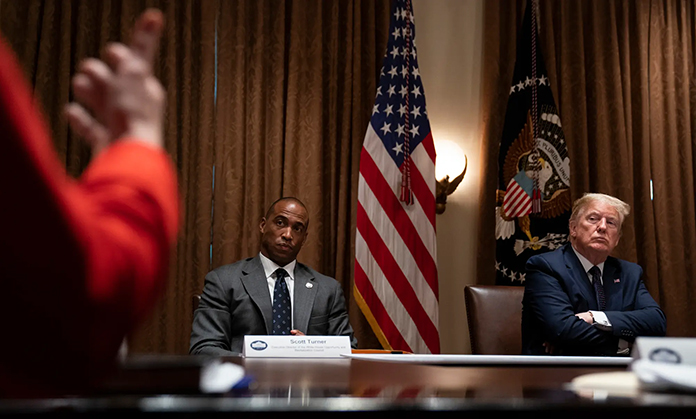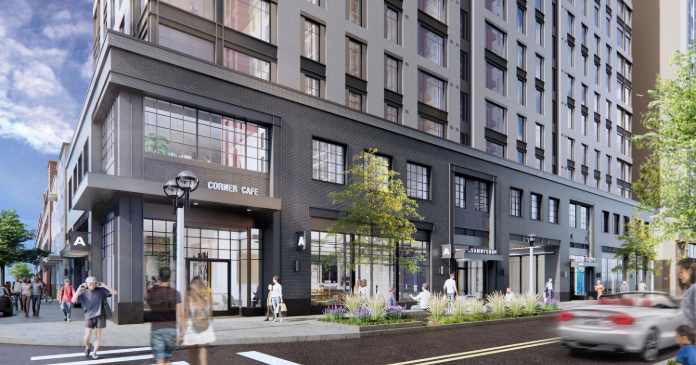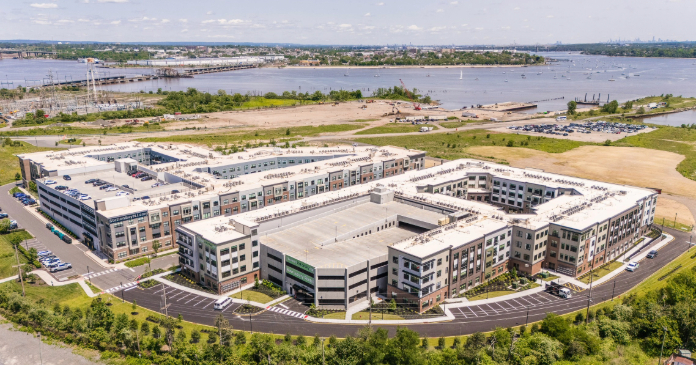While the 1,776-foot Freedom Tower seems to have grabbed all the headlines, the deal involving state and city agencies and developer Larry Silverstein, also paved the way for a solid residential element at Ground Zero.
When the titanic power struggle over the rebuilding of the World Trade Center was resolved in April, the project, including the soaring Freedom Tower, took a huge leap toward leaving the drawing board and becoming reality.
Under the so-called “framework agreement” that ended months of wrangling, Silverstein, a hard-driving negotiator who bought the World Trade Center lease just weeks before Sept. 11, will cede control of the Freedom Tower once it is built, as well as development rights to Tower 5 to the Port Authority of New York and New Jersey.
The Port Authority is expected to sell development rights to Tower 5, for an estimated $250 million. That building, which will rise at the site of the Deutsche Bank building that was badly damaged in the terror attacks — is expected to be a residential skyscraper.
Brokerage executives anticipate strong demand for the units — which they figure will number around 300. Then again, that’s the general feeling about lower Manhattan, which is in a virtual frenzy of residential conversions and ground-up building projects.
“Demand for a building (like Tower 5) will be very good,” predicts Alan Miller, director at Eastern Consolidated, a New York-based real estate investment services firm. “There is already incredible demand for downtown housing.”
Miller notes that a place to live downtown costs at least 25% less than any uptown alternative. Residential makes sense to many because downtown is already glutted with office space, even before Silverstein adds to the inventory.
“There was a cry for residential from the start among developers, planners and real estate professionals,” one brokerage executive says. “People feel that it makes more sense to round it out.”
Getting the rebuilding at Ground Zero going in earnest has been an epic task because of its scope and the differing agendas of those involved, from the developer to politicians to the families of the terror victims to planning and architecture critics, of which New York has an unsurpassed density.
At first, the $15-billion rebuilding went smoothly: Workers cleared away the rubble ahead of schedule and Developer Larry Silverstein erected one of the towers — a $700 million replacement of 7 World Trade Center, across the street from Ground Zero — last year. Tourists flocked to the site to pay homage before the scar in the ground disappeared. But the wrangling and second-guessing soon set in.
Much of it had to do with political leaders’ discomfort over having a private developer in charge of a site that had become a national shrine. Governor Pataki, who is expected to run for president in 2008, tried to outmaneuver Silverstein. He organized a worldwide architecture competition that ended in Daniel Libeskind’s design for a complex including the Freedom Tower.
Mayor Bloomberg, meanwhile, called repeatedly for Silverstein to relinquish control of the site, charging that he was moving too slowly. Pataki called for the renegotiation of Silverstein’s $3.2 billion lease.
The ensuing negotiations were stormy. In mid-March the Port Authority walked out of negotiations: Political leaders said Silverstein was greedy; he accused them of stalling rebuilding. After another month of negotiations between the city and the states of New York and New Jersey, a new proposal was sent to Silverstein, and he quickly agreed.
Bloomberg has long called for a balanced mix of uses at the World Trade Center site, including residential in one or more towers. Silverstein, meanwhile is an office space proponent, pointing to the transit amenities right at the site.
The Mayor’s office did not return calls, and a spokesman for Silverstein would only say that the developer sees towers one through four as “perfectly suited for corporate tenants.”
A complicating factor for creating housing is the fact that the Port Authority’s charter does not allow it to develop residential projects. Amending the charter was considered and dismissed as too complicated, sources say.
So another solution was developed. The Port Authority will have development rights for Tower 5. New York City, which owns the land through the Lower Manhattan Development Corp., is to rezone it for “highest and best use” as determined by the Port Authority. That opens the door to high-density housing. The Port Authority would then put the development rights out to bid.
One major caveat is that the framework agreement has not been finalized: The Port Authority will meet in September to ratify the deal. Given the rancorous and complicated negotiations, the prospect of the agreement falling apart, or being readjusted, remains.
But real estate leaders are hopeful. “I think there is generally a sense of resolve,” said Woody Heller, executive managing director at New York-based brokerage firm Studley.
There is already talk among the city’s real estate community that most of the housing will be apartments, with perhaps some condominiums and maybe even a hotel.
“The rage now is to do a hotel so that condo users would have hotel amenities like room service,” one source says.
Apartments may indeed win the day because of caution about the ability to sell a huge slate of condominiums, Heller said.
All five towers slated for Ground Zero are to be completed by 2012. Construction on the Freedom Tower, first proposed by Gov. Pataki in April 2003, is now under way and is expected to be complete in 2011.
Before Tower 5 can go up, the city must remove the damaged building standing on its site. Shrouded in black netting, 130 Liberty Street, formerly known as the Deutsche Bank Building, is being cleaned and deconstructed. That’s expected to be completed in Spring 2007, according to the Lower Manhattan Development Corp. a New York state and city controlled body created in the aftermath of the attacks to coordinate the rebuilding and revitalization of the island below Houston Street.
Like just about everything else at Ground Zero, the Tower 5 project would be further along if not for bureaucratic and legal delays. When the south Twin Tower collapsed on Sept. 11, it left a 15-story gash in the Deutsche Bank building. Its protective black shroud made the building a grim monument to the attacks.
The building’s interior was further damaged by dust, smoke, and black mold that fed on the moisture from the sprinkler system. Deutsche Bank declared the building uninhabitable.
But its insurers maintained that the building could be cleaned, repaired and re-inhabited. That led to litigation that tied up the building’s fate. To break the stalemate, Pataki in late 2003 appointed as mediator former senator George Mitchell. Finally, the LMDC acquired the building and is overseeing its deconstruction.
Residentially speaking, things are going gangbusters in Lower Manhattan. Much of the action is squarely in the financial district, from which banks and the law firms that served them had been departing even before the terror attacks. In many cases they are being replaced by luxury condos.
In 2005, eight major office buildings were converted into residential, a total of nearly 1.4 million square feet, according to brokerage firm Cushman & Wakefield. At 35 stories and 567,000 square feet, 20 Pine Street is one of the most prominent.
Developer Shaya Boymelgreen is converting the wedding cake-shaped office property at 20 Pine, formerly home to JP Morgan Chase, into luxury condos. Some 4 million additional feet of downtown conversions are on the drawing board, according to Cushman.
There is also plenty of ground-up residential development downtown, much of it in the shadow of Ground Zero. The Moinian Group, for instance, is shelling out $240 million to build a 53-story, 400,000-square-foot hotel and condo tower at 123 Washington St. The building, which is slated to have a 232-room W Hotel, 180 condo units and 77 rental units, will rise on the site of a 10-story office building that was irreparably damaged on Sept. 11, 2001 and torn down last year.
At 111 Washington St., Gerald Brauser replaced his six-story parking garage with a 52-story, 252-unit residential tower. And SDS Investments is having the Albanese Organization develop a 45-story luxury tower at 15 William Street, in the heart of the financial district.
The residential growth downtown — and the way it has taken commercial properties off the market — has been so rampant that it has chagrined those who hope to see the area regain its glory as a commercial hub. At the same time, others are concerned that a lack of affordable housing in the mix will limit the area’s cultural vitality by pricing out artists and youth.
Part of why downtown is hot is increased bustle, thanks to a residential grant program administered by the LMDC. The program gave away $281 million in 2002 and 2003, drawing thousands of new residents to the area while encouraging those already there to stay.
The program paid 20% of residents’ rent or mortgage, up to $12,000 over two years for those closest to ground zero. It also offered payments of $1,000 to $1,500 to those who lived in Lower Manhattan on Sept. 11 and chose to remain.
The re-population effort has been followed by an increase in amenities like stores, restaurants, theaters and transportation infrastructure. There’s a Whole Foods downtown, and there are now nearly as many residential buildings as commercial.
“Over the last several years it’s become more of a 24/7 community,” says Miller.
Transportation is the Fulton Transit Center at Fulton Street and Broadway. The grand subway hub will simplify and upgrade the maze-like complex that accommodates nine subway lines, while bridging six downtown subway stations.
The station, beneath a signature steel and glass dome, will also link NYC Transit facilities with PATH service and the World Trade Center site.
The bad news is that cost pressures in the $800 million project are pushing back the completion date as the Metropolitan Transportation Authority scrambles for ways to trim the bill. It’s now slated for completion in June 2009 rather than December 2007.
Government assistance is greasing the skids for Downtown development. Of the $8 billion in low-cost, tax-exempt Liberty Bonds authorized for the revitalization of lower Manhattan, up to $1.6 billion was earmarked for residential projects.
For example, developer Bruce Ratner received $243 million in Liberty Bonds for his Frank Gehry-designed Beekman Place project. The building will include a 24-story base housing public school and a healthcare center, and a 45-story residential tower.
Back at Ground Zero, most of the contentious issues appear on their way toward resolution, except for one big one.
Development of the memorial to the 9/11 victims has been plagued by controversy and delays.
Families of the victims have criticized the design. The lines of authority for the project have been in dispute. In April the head of the planning foundation stepped down in frustration amid criticism of the memorial’s ever-rising cost — the latest figure was nearly $1 billion.
The New York Times described the planning process recently as “seemingly spinning out of control.” Meanwhile, Pataki and Bloomberg have appointed developer Frank Sciame to lead a review process aimed at recommended changes that will bring the project in at $500 million.
So it’s within this dynamic, frenetic, sometimes acrimonious setting rife with money, politics and turf battles that Tower 5 will one day rise as a residential building.
But will New Yorkers balk at living at a location where just five years ago thousands of people perished?
Heller does not think so.
“I think the pain of that experience begins to soften, and people begin to think of it as an important place rather than a sad place,” he predicts.
Author: STEVE GARMHAUSEN
















